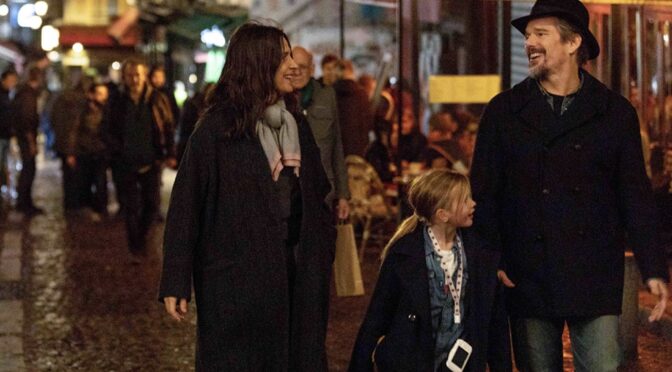 Hirokazu Kore-eda, directing for the first time outside of Japan, is clearly having a lot of fun with his title. The actors swill the words “the truth” around like a joke, almost giggling, though certainly with a little glint in their eyes. Such playfulness is central to how it establishes its drama. While this is a departure for Kore-eda, the tone and temperament of the film share a great deal with gentler works in the director’s filmography so far: I WISH, OUR LITTLE SISTER, and the first third of SHOPLIFTERS.
Hirokazu Kore-eda, directing for the first time outside of Japan, is clearly having a lot of fun with his title. The actors swill the words “the truth” around like a joke, almost giggling, though certainly with a little glint in their eyes. Such playfulness is central to how it establishes its drama. While this is a departure for Kore-eda, the tone and temperament of the film share a great deal with gentler works in the director’s filmography so far: I WISH, OUR LITTLE SISTER, and the first third of SHOPLIFTERS.
Fabienne Dangeville (Catherine Deneuve) is one of the great stars of the French cinema, and she’s publishing a memoir, entitled La Vérité. It’s at exactly this time that her daughter, Lumir (Juliette Binoche), a screenwriter in New York, arrives with her actor-husband Hank (Ethan Hawke, in amazing knitwear), and daughter, Charlotte (Clémentine Grenier). The relationship between mother and daughter is testy: there’s a buried argument to surface about an actor colleague of Fabienne’s, Sarah, who was close to the family, and one all ready to go about the book, which Lumir reads with pencil and post-it notes in hand, apt to point out its many fabrications, omissions, and exaggerations.
There’s another text in the film, about a fraught mother-daughter relationship, which is used to get to the heart of the matter. Fabienne’s fellow cast member is new star Manon (Manon Clavel), thought to be the heir to the position occupied by Sarah. The truth in THE TRUTH (see, it’s fun) is a matter of boundary-crossing: between the spontaneous and the planned, the scripted and the improvised, between honest feeling and performance. It’s not incidental that Kore-eda began his career as a documentarian.
Deneuve, with her role reflecting the position of her own career, is cold and callous, prepared with barbs for all occasions and superbly skilled at cutting someone down to size; except such a stance seems ridiculous when the recipients of her chastisements are her family. Hank is on the receiving end of one, taking it as agreeably as possible when Fabienne suggests he’s an “imitator” rather than an actor. Actors need presence, personality: it’s to be inferred he has neither. But Hawke does, and his laid back confidence and easy-going charm are undeniable: it’s a smallish role which he plays to near-perfection. And speaking of presence and personality: Binoche.
If we think of actors as auteurs, as a recent Reverse Shot symposium devoted to this actor did, then Binoche’s is one of the most durable and impressive bodies of work in modern cinema. Her run of performances from CERTIFIED COPY through to THE TRUTH is basically unmatchable. Here, the resentments Lumir holds towards her mother are worked through stealthily, with an evasive and typically Kore-eda-like wryness of humour. Still, there’s no denying the pain her confrontational pose against Fabienne exhibits, and no denying her expression of it. In Claire Denis’s UN BEAU SOLEIL INTÉRIEUR, Binoche’s Isabelle pivots with amazing dexterity between hopeful, despondent, delighted, and defeated, sometimes all in the same action, look, or gesture. Well, there’s a bit of Binoche business which achieves exactly that near the end of THE TRUTH, where Lumir tries to hide an uncontainable smile behind her hand, at the same moment tears begin cresting on her eyelids. Such a simple gesture, but precisely right for the moment and the film.
There’s one other way THE TRUTH is a departure for Kore-eda: in terms of style. The camera moves more freely here than usual; it’s not that his films don’t feature mobile camerawork, it’s just that any movements are so keenly motivated. A scene during dinner, as Fabienne and Hank half begin understanding each other, features a strangely articulated tracking shot, only ceasing to move once one is firmly within the other’s confidence. THE TRUTH is looser than Kore-eda normally allows.
Similarly, during the film shoot in the narrative, Kore-eda and cinematographer Eric Gautier fashion sly, sometimes shrewd ways of integrating the film’s own mise-en-scene with that of the film Fabienne is starring in. An establishing shot will show the crew at work, arranging the set, keeping the lens in focus, organising the sound equipment; cut to the scene being shot as seen through the camera filming; cut again, this time incorporating the rushes monitor, and again, this time to the reverse angle, so the audience can see both the scene being filmed and the people filming it. The intimacy suggested in the scene is an illusion, because there are so many people around to witness it. But even in a crowded room, even if it’s artificial, for the camera, subject to rewriting and improvisation, it’s still intimacy: still, in a vast sense, true. This lovely movie knows exactly what it’s doing.

